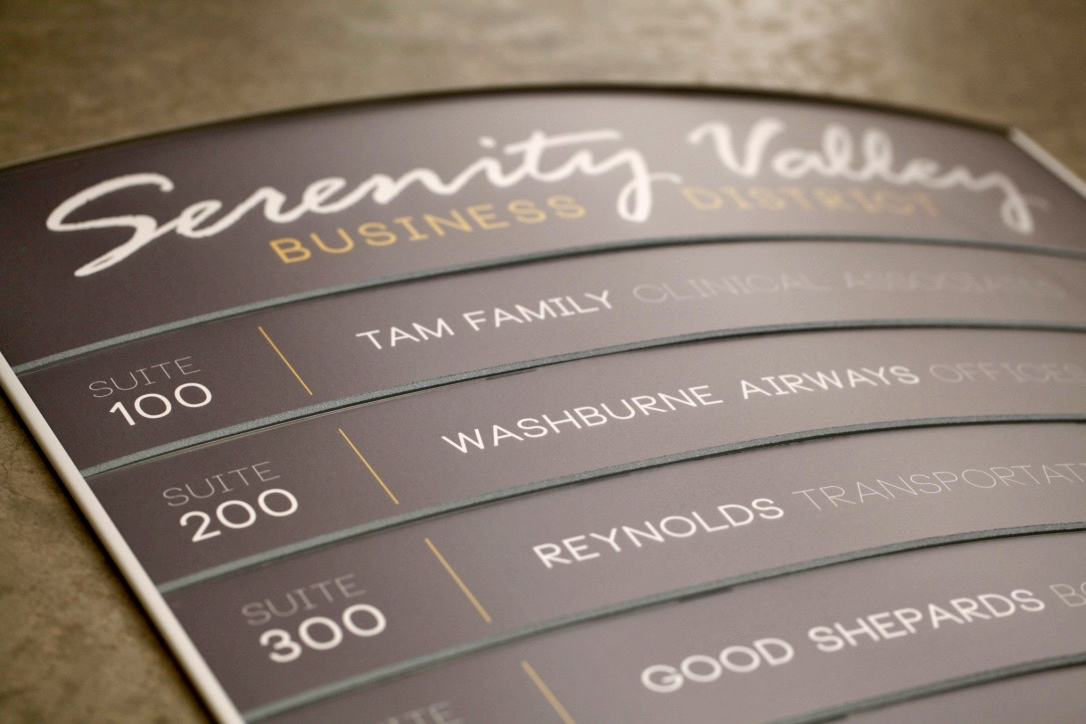
What is wayfinding?!
If you were like me (prior to my time working for a sign company), you have probably heard the term ‘wayfinding’ floating around in regards to signage, maps, or other various topics of discussion. Although you are familiar with the term, it’s doubtful that you have taken the time to research exactly what wayfinding means and what role it plays in your building.
Reginald Golledge, in his book, Wayfinding Behavior: Cognitive Mapping and Other Spatial Processes, defineswayfinding as “the process of determining and following a path or route between an origin and a destination.” If you break down the word, the definition becomes a lot more comprehensible–wayfinding is literally how you find your way to a desired location. According to Golledge, there are three components that any wayfinding device must employ to be truly successful:
- Must be purposive
- Must be directed
- Must be motivated
Throughout this article, we will break down the role wayfinding signage plays in your workplace, and why it is so important for us to incorporate wayfinding signs in our buildings.
Is wayfinding signage really that important?!
It depends. Do you really want people to hate walking through your building? In all seriousness, wayfinding signage has become increasingly important in recent years as it becomes more commonplace. It’s human nature to desire visual cues which help us navigate our way through life–the same desire applies when visiting new locations.
Michael J. O’Neill’s 1991 Study examined the effects of signage on wayfinding accuracy. The study involved looking at the influence of several types of signage on the ease of navigation through a series of buildings on a university campus. O’Neill’s study confirmed the benefits of signage as a wayfinding tool, as the addition of signage resulted in a 13% increase in rate of travel. The addition of signage also resulted in a 50% decrease in wrong turns and a 62% decrease in backtracking.
Furthermore, a 2000 study by Romedi Passini and her colleagues, focused on the effects of wayfinding in a nursing home for patients with advanced dementia. What this study found was that signage has a very important function for patients with dementia, as they create redundancy in wayfinding communication and compensate for the loss of memory and spatial understanding.
More recently, wayfinding signage has been utilized as a means to promote physical fitness. Allow me to explain. A group based out of North Carolina received attention for the “guerilla wayfinding” tactics they employed, by lashing up DIY signs across the city of Raleigh, NC. These signs had text written on them such as “It is a 5 minute bike to Atlantic Station.” The messages on all of these signs that were posted across the city were aimed to promote people getting out of their cars and enjoying the city in a new way. Pretty awesome, right?
Wayfinding signage is clearly important for a variety of reasons. Not only does it cut down travel time in new locations, but it also has been proven to decrease the amount of wrong turns and backtracking experienced while walking through a new location, and create redundancy that can compensate for the loss of memory. It can even promote physical fitness, and make walking around a new location more enjoyable! Keep these points in mind when trying to explain the need for new wayfinding signage to your purchasing departments.
Tips for making your signage more wayfinding-friendly
In order to come up with the type of signage that is most conducive to foolproof wayfinding, let’s revisit the three components of wayfinding that were introduced by Reginald Golledge. Wayfinding signs must be the following: (1) purposive, (2) directed, (3) motivated.
To make your signage purposive, you must first realize what your purpose is in creating the new signage. Have you had recent complaints that rooms within your building were difficult to find? Are people constantly asking where the elevators, restrooms, or other facilities are? Here are some ways to eliminate these issues:
- Make sure your wayfinding signage is necessary
- Place your wayfinding signage in an area of high traffic, or high confusion
- Make sure the sign speaks for itself
Once the purpose of the signage has been determined, we must ensure that the signage is directed. In order to have a sign that directs individuals to the area in the building they wish to be, there are a few things you must consider. Here are a few tips on creating directed wayfinding signs:
- Equip your sign with arrows and other visual cues
- Make sure your sign is legible, easily-seen, and helpful
- Accuracy. Accuracy. Accuracy. These signs better tell the true story!
Finally, your wayfinding signs should be motivated. No, I’m not talking about putting quotes such as “Be the best you” on your signs–I’m talking about signs that grab your audience’s attention and motivate sign viewers to go to the areas in the building they are being directed to. Here’s how you make sure your signs are motivated:
- Make your sign aesthetically-pleasing. Design is key!
- Your wayfinding signage should be consistent throughout the building.
- Don’t overwhelm them with information. Be concise.
Ultimately, you should look at the implementation of wayfinding signage as one of the most fundamental steps in making your building more user-friendly. You often hear web developers speak of “user-interface.” The same devotion to great user experience is necessary for building planners! Make sure you have signage that meets the requirements of being purposive, directed, and motivated.
Example of a great wayfinding sign
This wayfinding directory is one of the products we offer on our website. Remember our device for measuring the effectiveness of a wayfinding sign: purposive, directed, and motivated. Below is a checklist of the tips that we used for making a wayfinding sign:
- Make sure your wayfinding signage is necessary (YES–a directory sign like this is absolutely necessary in a large building, in which suites are numbered and occupants of each suite are displayed.)
- Place your wayfinding signage in an area of high traffic, or high confusion (YES–this sign will be placed in the lobby of the building, the area with the most traffic and the area in which people are looking for answers.)
- Make sure the sign speaks for itself (YES–after seeing this sign, you are able to tell where the suite you are looking for is, as well as what businesses are in each suite.)
- Equip your sign with arrows and other visual cues (YES–although arrows are not included in this particular sign, the signage as a whole is very easy to read and visual cues align the suite number with the name of the business occupying the suite. Arrows can be presumed to be a part of other wayfinding signage within the building.)
- Make sure your sign is legible, easily-seen, and helpful (YES–this sign is clean as can be, as all text and numbers are spaced well and the font is easy to read, even from a distance.)
- Accuracy. Accuracy. Accuracy. These signs better tell the true story! (YES–this sign certainly isn’t hiding any information, nor misleading anyone. The suites are accurate, up-to-date, and correctly display the occupant.)
- Make your sign aesthetically-pleasing. Design is key! (YES–although the colors are relatively neutral, the design is modern and the curve in the sign adds a great stylistic element. It is an aesthetically-pleasing directory sign.)
- Your wayfinding signage should be consistent throughout the building. (YES–consistency is key, and the branding at the top of the directory prominently shows the building’s name and is presumed to be consistent throughout the building. Color schemes should also match here!)
- Don’t overwhelm them with information. Be concise. (YES–this sign is far from cluttered. Everything is legible, spaced out correctly, and most importantly, there is not unnecessary text anywhere on the page. This is a great example of wayfinding signage.)
For more examples of wayfinding signage that is up-to-date and necessary for your building, please
visit here.
Written By: Jack Yakowicz
Account Manager at Office Sign Company
jack@officesigncompany.com










